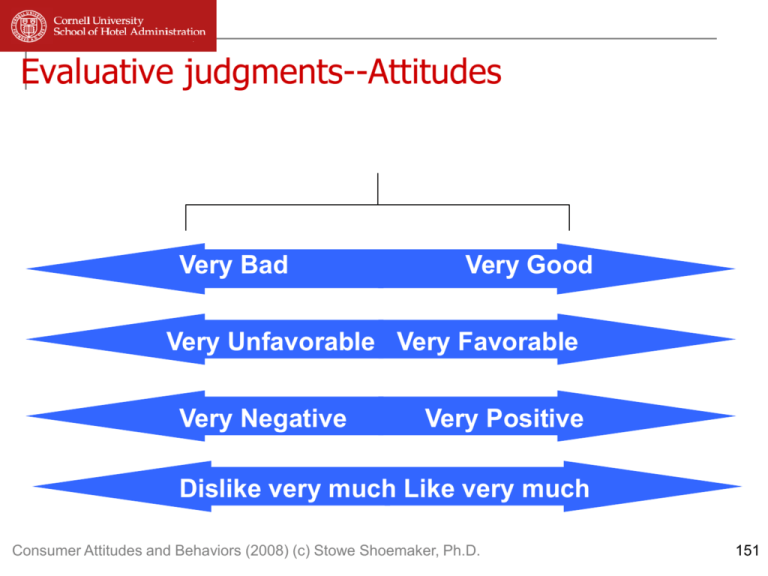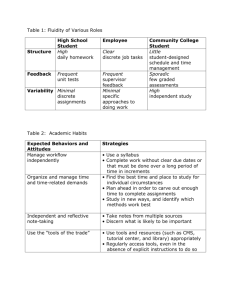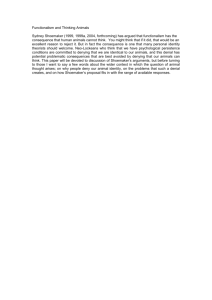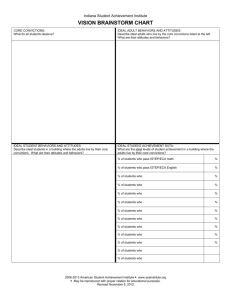Consumer Attitudes and Behaviors Part 4 of 7
advertisement

Evaluative judgments--Attitudes Attitudes-- Evaluative judgments at any point on a continuum Very Bad Very Good Very Unfavorable Very Favorable Very Negative Very Positive Dislike very much Like very much Consumer Attitudes and Behaviors (2008) (c) Stowe Shoemaker, Ph.D. 151 152 Consumer Attitudes and Behaviors (2008) (c) Stowe Shoemaker, Ph.D. 152 Attitudes Definition: comes from the Latin term “aptus,” which means “fitness”’ or “adaptiveness” Thurston: the amount of affect or feeling for or against a stimulus Peter & Olsen “overall evaluation of a concept” Consumer Attitudes and Behaviors (2008) (c) Stowe Shoemaker, Ph.D. 153 Characteristics of Attitudes Direction: can be positive, negative, or neutral Magnitude: degree of favorability or negativity; extremity of liking or disliking Ambivalence/Internal Consistency: degree to which underlying cognitions or beliefs are similar in evaluative criteria Consumer Attitudes and Behaviors (2008) (c) Stowe Shoemaker, Ph.D. 154 Characteristics of Attitudes Centrality: degree to which knowledge about attitude object is closely connected to important, central end goals, needs, values Interrelatedness: degree to which knowledge about attitude object is interconnected amongst itself and is associated with other knowledge Consumer Attitudes and Behaviors (2008) (c) Stowe Shoemaker, Ph.D. 155 Characteristics of Attitudes Emotionality: degree of emotionality associated with the attitude object Stability: Consistency or sameness of attitude and related cognitive structures over time and situations Consumer Attitudes and Behaviors (2008) (c) Stowe Shoemaker, Ph.D. 156 Tricomponent Attitude Model Affect Conation Cognition Consumer Attitudes and Behaviors (2008) (c) Stowe Shoemaker, Ph.D. 157 Tricomponent Attitude Model Cognitive Knowledge and perceptions Attitudes and beliefs Need for Cognition Consumer Attitudes and Behaviors (2008) (c) Stowe Shoemaker, Ph.D. 158 Tricomponent Attitude Model Affect Emotions or feelings Evaluative (e.g., favorable, unfavorable) Emotionally charged states (happy, sadness, etc.) Consumer Attitudes and Behaviors (2008) (c) Stowe Shoemaker, Ph.D. 159 Tricomponent Attitude Model Conative (behavior) Likelihood or tendency that an individual will undertake a specific action or behave in a certain way Frequently treated as “intention to buy” Consumer Attitudes and Behaviors (2008) (c) Stowe Shoemaker, Ph.D. 160 Persuading people to make an evaluative judgment about drinking and driving Consumer Attitudes and Behaviors (2008) (c) Stowe Shoemaker, Ph.D. 161 162 Consumer Attitudes and Behaviors (2008) (c) Stowe Shoemaker, Ph.D. 162 Consumer Attitudes and Behaviors (2008) (c) Stowe Shoemaker, Ph.D. 163 Four Functions of Attitudes Utilitarian Function Ego-Defensive Function Knowledge Function Value-Expressive Function Consumer Attitudes and Behaviors (2008) (c) Stowe Shoemaker, Ph.D. 164 Utilitarian Function People express feelings to maximize rewards and minimize punishments received from others; e.g., express favorable attitudes about something to win support of someone who you suspect as similar attitudes Consumer Attitudes and Behaviors (2008) (c) Stowe Shoemaker, Ph.D. 165 Ego-Defensive Function self-esteem maintenance function; attitudes held to protect people from basic truths Consumer Attitudes and Behaviors (2008) (c) Stowe Shoemaker, Ph.D. 166 Knowledge Function Helps a person to give meaning to the unorganized and chaotic world; i.e., form a frame of reference by which the world is interpreted; e.g., have a positive attitude towards a brand, buy it all the time to simplify life Consumer Attitudes and Behaviors (2008) (c) Stowe Shoemaker, Ph.D. 167 Value-Expressive Function social identify function; people express positive views about products, brands, services, etc. to make a statement about themselves; e.g., like to stay in Ritz Carlton Hotels because means I have arrived Consumer Attitudes and Behaviors (2008) (c) Stowe Shoemaker, Ph.D. 168 How Are Attitudes Formed Formed by integrating salient beliefs about attitude concept Come from: exposure to an advertisement comment from a friend while making a purchase decision articles in Consumer Reports; etc. Consumer Attitudes and Behaviors (2008) (c) Stowe Shoemaker, Ph.D. 169 Attitude Toward Object States three major factors are predictive of attitudes salient beliefs strength of belief evaluation of each salient belief Consumer Attitudes and Behaviors (2008) (c) Stowe Shoemaker, Ph.D. 170 Attitude Toward Object Ao = overall attitude towards object “o” bi = strength of the belief of whether or not object o has some particular attribute “i” ei = evaluation of the goodness or badness of attribute “i” bi = 1 “extremely unlikely” 10 “extremely likely” that you buy car with attribute x ei = -3 = “very bad” +3 = “very good” Consumer Attitudes and Behaviors (2008) (c) Stowe Shoemaker, Ph.D. 171 172 Corvette Buick Park Avenue Mercedes 300 E Attribute ei bi bi x e i bi bi x e i bi bi x e i Sporty styling +3 8 24 5 15 7 21 Good handling/ride +3 8 24 4 12 7 21 High cost -1 7 -7 6 -6 8 -8 Great acceleration +3 7 21 3 9 6 18 Low repair frequency +1 3 3 2 2 8 8 SUM +65 +32 +60 Attribute ei bi bi x e i bi bi x e i bi bi x e i Sporty styling -1 9 -9 5 -5 7 -7 Good handling/ride +3 3 9 9 27 7 21 High cost -3 8 -24 6 -18 10 -30 Great acceleration -2 10 -20 2 -4 6 -12 Low repair frequency +3 2 6 8 22 9 27 Consumer Ph.D. SUM Attitudes and Behaviors (2008) (c) Stowe Shoemaker, -38 +24 -1 172 Level of Specificity of Attitude Concept There are different levels of specificity; implication is that when measuring attitudes, one must precisely identify the attitude concept, at the level of abstraction and specificity that is most relevant to the marketing problem of interest; Consumer Attitudes and Behaviors (2008) (c) Stowe Shoemaker, Ph.D. 173 Specificity of Attitude Concept “How do you feel about Marriott Hotels” vs. “How do you feel about the Marriott Hotel located at the corner of Green Valley Parkway and Sunset” Consumer Attitudes and Behaviors (2008) (c) Stowe Shoemaker, Ph.D. 174 Changing Attitudes Associate the Product with a Special Group, Event, or Cause Resolve Two or More Conflicting Attitudes Change the Relative Evaluation of Attributes Change Brand Beliefs Add an Attribute Change Brand Overall Rating Change Belief about Competitor Consumer Attitudes and Behaviors (2008) (c) Stowe Shoemaker, Ph.D. 175 How to Change Attitudes Add a new salient belief Change the strength (bi) of an existing salient belief Change the evaluation (ei) of an existing salient belief Make an existing belief more salient Consumer Attitudes and Behaviors (2008) (c) Stowe Shoemaker, Ph.D. 176 Conative (behavior) The behavior involves four distinct elements the action: (i.e., the behavior one is trying to measure); e.g., purchase of a hotel room the target: (the thing at which a behavior is directed); e.g., purchase of a Marriott hotel room Consumer Attitudes and Behaviors (2008) (c) Stowe Shoemaker, Ph.D. 177 Conative (behavior) the context: e.g., staying at a Marriott for business vs. staying at a Marriott for pleasure the time: e.g., perhaps if late at night stay not at a Marriott, but first place you find Consumer Attitudes and Behaviors (2008) (c) Stowe Shoemaker, Ph.D. 178 Correspondence with Attitudes and Conative (behavior) Ao misses action, context, and time elements; thus, attitudes toward a brand can be unrelated to attitudes toward buying the brand Need to understand attitude towards the action Consumer Attitudes and Behaviors (2008) (c) Stowe Shoemaker, Ph.D. 179 Theory of Reasoned Action Basic Tenet: A person’s intention is a function of two basic determinants Consumer Attitudes and Behaviors (2008) (c) Stowe Shoemaker, Ph.D. 180 Attitude towards the behavior Individual’s positive or negative evaluation of performing the behavior; the beliefs that underlie attitudes towards the behavior are called the behavioral beliefs; e.g. of attitude toward the behavior of buying Miller Beer Consumer Attitudes and Behaviors (2008) (c) Stowe Shoemaker, Ph.D. 181 A action = bi * ei A action = overall attitude towards action bi = strength of the belief that performing the action will result in consequence “i” ei = evaluation of the goodness or badness of consequence “i” Consumer Attitudes and Behaviors (2008) (c) Stowe Shoemaker, Ph.D. 182 Social Norm Person’s perception of the social pressures put on her/him to perform or not perform the behavior in question the beliefs that underlie a person’s subjective norm are termed normative beliefs Consumer Attitudes and Behaviors (2008) (c) Stowe Shoemaker, Ph.D. 183 Formula for Subjective Norm Nbj = normative belief that a referent group j thinks that consumer should/ should not perform behavior MCj = motivation to comply with influence of referent j Consumer Attitudes and Behaviors (2008) (c) Stowe Shoemaker, Ph.D. 184 Final Formula Behavior Behavioral Intention = W1 (AB) + W2 (SN) AB = attitude towards the action SN = subjective norms W1 and W2 = empirically determined weights Consumer Attitudes and Behaviors (2008) (c) Stowe Shoemaker, Ph.D. 185 186 Theory of Reasoned Action Belief that the behavior leads to certain outcomes Attitude toward the behavior Evaluation of the outcomes Intention Beliefs that specific referents think I should or should not perform the behavior Behavior Subjective norm Motivation to comply with the specific referents Consumer Attitudes and Behaviors (2008) (c) Stowe Shoemaker, Ph.D. 186 Commercial McDonald’s Wedding Club 18-30 Consumer Attitudes and Behaviors (2008) (c) Stowe Shoemaker, Ph.D. 187 Balance Theory Balance theory suggests that attitude inconsistencies can lead to persuasion. Balance theory focuses on consistency between a person (p), another person known to p (o) and a stimulus (x). Balance exists if all three relations are positive (e.g., the friend of my friend is my friend) or if two relations are negative and one is positive (the enemy of my enemy is my friend). Consumer Attitudes and Behaviors (2008) (c) Stowe Shoemaker, Ph.D. 188 Applying balance theory Consumer Attitudes and Behaviors (2008) (c) Stowe Shoemaker, Ph.D. 189 Consumer Attitudes and Behaviors (2008) (c) Stowe Shoemaker, Ph.D. 190 Consumer Attitudes and Behaviors (2008) (c) Stowe Shoemaker, Ph.D. 191 Question Describe an instance from your own experience in which social norms conflicted with your own attitude. What behavior did you adopt? Why Consumer Attitudes and Behaviors (2008) (c) Stowe Shoemaker, Ph.D. 192 Exercise If you worked for a resort that vacationers were likely to visit about once a year, how would you use information presented to get customers to return? Consumer Attitudes and Behaviors (2008) (c) Stowe Shoemaker, Ph.D. 193 Case Study: American Legacy Research has shown that 80% of all smokers begin smoking before the age of 18. Why is smoking so attractive to a thirteen-year-old? What was the rationale behind Legacy’s decision to focus on prevention, and target sensation-seeking teens between the ages of 12 and 17? Do you agree with this rationale? Legacy made a number of interesting decisions with respect to the truth advertising campaign. For example, it decided that (1) the campaign would not be a “call to action;” i.e., that the ads would not urge kids to quit smoking; (2) it would not identify itself as the sponsor of any of the ads; (3 it would focus exclusively on the tobacco industry – rather than politicians, parents, the media, marketers, etc – as the enemy in all the ads; and (4) it would use graphic images such as body bags, urine, dog feces, etc, to communicate its message. Do you agree with these decisions? How “truthful” was this campaign? Consumer Attitudes and Behaviors (2008) (c) Stowe Shoemaker, Ph.D. 194 Case Study: American Legacy How was the truth campaign different than most traditional public service campaigns? More generally, why are most traditional public service campaigns ineffective? By comparison, how effective was the truth campaign? What accounts for its success? What are the benchmarks you are using to evaluate its success? Why did Legacy decide to build a truth “brand” rather than stay with the traditional PSA paradigm? From Legacy’s perspective, was the difference simply semantic, or was it more significant than that? In what ways is truth brand the same/different as other well-known brands, like Nike, Disney, or Mercedes-Benz? Consumer Attitudes and Behaviors (2008) (c) Stowe Shoemaker, Ph.D. 195









